History of colonialism

The historical phenomenon of colonization is one that stretches around the globe and across time. Ancient and medieval colonialism was practiced by the Phoenicians, Greeks, Turks, and Arabs.
Colonialism in the modern sense began with the "Age of Discovery", led by the Portuguese, who became increasingly expansionist following the conquest of Ceuta in 1415, aiming to control navigation through the Strait of Gibraltar, spread Christianity, amass wealth and plunder, and suppress predation on Portuguese populations by Barbary pirates as part of a longstanding African slave trade; at that point a minor trade, one the Portuguese would soon reverse and surpass. Around 1450, based on North African fishing boats, a lighter ship was developed, the caravel, which could sail further and faster,[1] was highly maneuverable, and could sail "into the wind".
Enabled by new nautical technology, with the added incentive to find an alternative "Silk Road" after the fall of Constantinople in 1453 to the Ottoman Empire effectively closed profitable trade routes with Asia, early European exploration of Africa was followed by the Spanish exploration of the Americas, further exploration along the coasts of Africa, and explorations of West Asia (also known as the Middle East), South Asia, and East Asia.
The conquest of the Canary Islands by the Crown of Castile, from 1402 to 1496, has been described as the first instance of European settler colonialism in Africa. In 1462, the previously uninhabited Cape Verde archipelago became the first European settlement in the tropics, and thereafter a site of Jewish exile during the height of the Spanish Inquisition in the 1490s; the Portuguese soon also brought slaves from the West African coast. Because of the economics of plantations, especially sugar, European colonial expansion and slavery would remain linked into the 1800s. The use of exile to penal colonies would also continue.
The European "discovery" of the New World, as named by Amerigo Vespucci in 1503, opened another colonial chapter, beginning with the colonization of the Caribbean in 1493 with Hispaniola (later to become Haiti and the Dominican Republic). The Portuguese and Spanish Empires were the first global empires because they were the first to stretch across different continents (discounting Eurasian empires and those with land in Africa along the Mediterranean), covering vast territories around the globe. Between 1580 and 1640, the Portuguese and Spanish empires were both ruled by the Spanish monarchs in personal union. During the late 16th and 17th centuries, England, France, and the Dutch Republic also established their own overseas empires, in direct competition with one another.
The end of the 18th and mid 19th century saw the first era of decolonization, when most of the European colonies in the Americas, notably those of Spain, New France, and the Thirteen Colonies, gained their independence from their metropole. The Kingdom of Great Britain (uniting Scotland and England), France, Portugal, and the Dutch turned their attention to the Old World, particularly South Africa and South Asia, particularly Southeast Asia, where coastal enclaves had already been established.
In the 19th century, the Second Industrial Revolution led to what has been termed the era of New Imperialism, when the pace of colonization rapidly accelerated, the height of which was the Scramble for Africa, in which Belgium, Germany, and Italy were also participants.
There were deadly battles between colonizing states and revolutions from colonized areas shaping areas of control and establishing independent nations. During the 20th century, the colonies of the defeated central powers in World War I were distributed amongst the victors as mandates, but it was not until the end of World War II that the second phase of decolonization began in earnest.
Periodisation

Some commentators identify three waves of European colonialism.[2]
The two main countries in the first wave of European colonialism were Portugal and Spain.[3] The Portuguese started the long age of European colonization with the conquest of Ceuta, Morocco in 1415, and the conquest and discovery of other African territories and islands, this would also start the movement known as the Age of Discoveries. The Spanish and Portuguese launched the colonization of the Americas, basing their territorial claims on the Treaty of Tordesillas of 1494. This treaty demarcated the respective spheres of influence of Spain and Portugal.[4]
The expansion achieved by Spain and Portugal caught the attention of Britain, France, and the Netherlands.[5] The entrance of these three powers into the Caribbean and North America perpetuated European colonialism in these regions.[6]
The second wave of European colonialism commenced with Britain's involvement in Asia in support of the British East India Company; other countries such as France, Portugal and the Netherlands also had involvement in European expansion in Asia.[7][8]
The third wave ("New Imperialism") consisted of the Scramble for Africa regulated by the terms of the Berlin Conference of 1884–1885. The conference effectively divided Africa among the European powers. Vast regions of Africa came under the sway of Britain, France, Germany, Portugal, Belgium, Italy and Spain.[9][10]
Gilmartin argues that these three waves of colonialism were linked to capitalism. The first wave of European expansion involved exploring the world to find new revenue and perpetuating European feudalism. The second wave focused on developing the mercantile capitalism system and the manufacturing industry in Europe. The last wave of European colonialism solidified all capitalistic endeavours by providing new markets and raw materials.[11]
As a result of these waves of European colonial expansion, only fourteen present-day independent countries escaped formal colonization by European powers: Afghanistan, Ethiopia, Bhutan, China, Iran, Japan, Liberia, Mongolia, Nepal, North Korea, Saudi Arabia, South Korea, Thailand, and Turkey as well as North Yemen, the former independent country which is now part of Yemen.[12]
Colonialism in ancient times (3200 BC – 7th century AD)
Arab colonization: North Africa and the Middle East (7th century–8th century)
Portuguese and Spanish colonial hegemony: the Americas (15th century–1770)

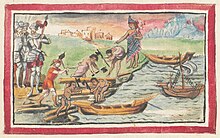
European colonization of both Eastern and Western Hemispheres has its roots in Portuguese exploration. There were financial and religious motives behind this exploration. By finding the source of the lucrative spice trade, the Portuguese could reap its profits for themselves. They would also be able to probe the existence of the fabled Christian kingdom of Prester John, with an eye to encircling the Islamic Ottoman Empire, itself gaining territories and colonies in Eastern Europe. The first foothold outside of Europe was gained with the conquest of Ceuta in 1415. During the 15th century, Portuguese sailors discovered the Atlantic islands of Madeira, Azores, and Cape Verde, which were duly populated, and pressed progressively further along the west African coast until Bartolomeu Dias demonstrated it was possible to sail around Africa by rounding the Cape of Good Hope in 1488, paving the way for Vasco da Gama to reach India in 1498.[13]
Portuguese successes led to Spanish financing of a mission by Christopher Columbus in 1492 to explore an alternative route to Asia, by sailing west. When Columbus eventually made landfall in the Caribbean Antilles he believed he had reached the coast of India, and that the people he encountered there were Indians with red skin. This is why Native Americans have been called Indians or red-Indians. In truth, Columbus had arrived on a continent that was new to the Europeans, the Americas. After Columbus' first trips, competing Spanish and Portuguese claims to new territories and sea routes were solved with the Treaty of Tordesillas in 1494, which divided the world outside of Europe in two areas of trade and exploration, between the Iberian kingdoms of Castile and Portugal along a north-south meridian, 370 leagues west of Cape Verde. According to this international agreement, the larger part of the Americas and the Pacific Ocean were open to Spanish exploration and colonization, while Africa, the Indian Ocean, and most of Asia were assigned to Portugal.[14]
The boundaries specified by the Treaty of Tordesillas were put to the test in 1521 when Ferdinand Magellan and his Spanish sailors (among other Europeans), sailing for the Spanish Crown became the first European to cross the Pacific Ocean,[15] reaching Guam and the Philippines, parts of which the Portuguese had already explored, sailing from the Indian Ocean. The two by now global empires, which had set out from opposing directions, had finally met on the other side of the world. The conflicts that arose between both powers were finally solved with the Treaty of Zaragoza in 1529, which defined the areas of Spanish and Portuguese influence in Asia, establishing the anti-meridian, or line of demarcation on the other side of the world.[16]
During the 16th century the Portuguese continued to press both eastwards and westwards into the Oceans. Towards Asia they made the first direct contact between Europeans and the peoples inhabiting present day countries such as
Spanish treatment of the indigenous populations caused a fierce debate, the
The
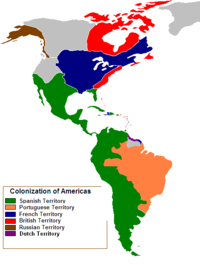
As characteristically happens in any colonialism, European or not, previous or subsequent, both Spain and Portugal profited handsomely from their newfound overseas colonies: the Spanish from gold and silver from mines such as
Northern European challenges to the Iberian hegemony
It was not long before the exclusivity of Iberian claims to the Americas was challenged by other up and coming European powers, primarily the Netherlands, France and England: the view taken by the rulers of these nations is epitomized by the quotation attributed to Francis I of France demanding to be shown the clause in Adam's will excluding his authority from the New World. This challenge initially took the form of piratical attacks (such as those by Francis Drake) on Spanish treasure fleets or coastal settlements.[21] Later the Northern European countries began establishing settlements of their own, primarily in areas that were outside of Spanish interests, such as what is now the eastern seaboard of the United States and Canada, or islands in the Caribbean, such as Aruba, Martinique, and Barbados, that had been abandoned by the Spanish in favor of the mainland and larger islands.[22]
Whereas Spanish colonialism was based on the religious conversion and exploitation of local populations via encomiendas (many Spaniards emigrated to the Americas to elevate their social status, and were not interested in manual labor), Northern European colonialism was bolstered by those emigrating for religious reasons (for example, the Mayflower voyage). The motive for emigration was not to become an aristocrat or to spread one's faith but to start a new society afresh, structured according to the colonist's wishes. The most populous emigration of the 17th century was that of the English, who after a series of wars with the Dutch and French came to dominate the Thirteen Colonies on the eastern coast of the present-day United States and other colonies such as Newfoundland and Rupert's Land in what is now Canada.[23]
However, the English, French and Dutch were no more averse to making a profit than the Spanish and Portuguese, and whilst their areas of settlement in the Americas proved to be devoid of the precious metals found by the Spanish, trade in other commodities and products that could be sold at a massive profit in Europe provided another reason for crossing the Atlantic, in particular, furs from Canada, tobacco, and cotton grown in Virginia and sugar in the islands of the Caribbean and Brazil. Due to the massive depletion of indigenous labor, plantation owners had to look elsewhere for manpower for these labour-intensive crops. They turned to the centuries-old slave trade of west Africa and began transporting Africans across the Atlantic on a massive scale – historians estimate that the Atlantic slave trade brought between 10 and 12 million black African slaves to the New World. The islands of the Caribbean soon came to be populated by slaves of African descent, ruled over by a white minority of plantation owners interested in making a fortune and then returning to their home country to spend it.[24]
Role of companies in early colonialism
From its very outset, Western colonialism was operated as a joint public-private venture. Columbus' voyages to the Americas were partially funded by Italian investors, but whereas the Spanish state maintained a tight rein on trade with its colonies (by law, the colonies could only trade with one designated port in the mother country and treasure was brought back in special
European colonies in India
In May 1498, the
Colonialism within Europe (16th–20th century)
Imperial Russia: Central Asia and Siberia (16th–20th century)
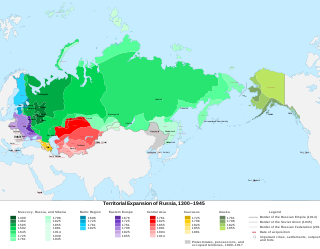
The territorial evolution of Russia happened by means of military conquest and by ideological and political unions over the centuries.[27] This section covers (1533–1914).[28]
After
- the culture of Russia and that of the Caucasian peoples interacted in a reciprocally beneficial manner. The turbulent tenor of life in the Caucasus, the mountain peoples' love of freedom, and their willingness to die for independence were felt far beyond the local interaction of the Caucasian peoples and coresident Russians: they injected a potent new spirit into the thinking and creative work of Russia's progressives, strengthened the liberationist aspirations of Russian writers and exiled Decembrists, and influenced distinguished Russian democrats, poets, and prose writers, including Alexander Griboyedov, Alexander Pushkin, Mikhail Lermontov, and Leo Tolstoy. These writers, who generally supported the Caucasian fight for liberation, went beyond the chauvinism of the colonial autocracy and rendered the Caucasian peoples' cultures accessible to the Russian intelligentsia. At the same time, Russian culture exerted an influence on Caucasian cultures, bolstering positive aspects while weakening the impact of the Caucasian peoples' reactionary feudalism and reducing the internecine fighting between tribes and clans.[31]
Expansion into Asia
The first stage to 1650 was an expansion eastward from the Ural Mountains to the Pacific Ocean.[32][33] Geographical expeditions mapped much of Siberia. The second stage from 1785 to 1830 looked south to the areas between the Black Sea and the Caspian Sea. The key areas were Armenia and Georgia, with some better penetration of the Ottoman Empire, and Persia. By 1829, Russia controlled all of the Caucasus as shown in the Treaty of Adrianople of 1829. The third era, 1850 to 1860, was a brief interlude jumping to the East Coast, annexing the region from the Amur River to Manchuria. The fourth era, 1865 to 1885 incorporated Turkestan, and the northern approaches to India, sparking British fears of a threat to India in the Great Game.[34]
Maritime South–East Asia and the Dutch East India Company (16th–20th century)
First decolonization: Independence in the Americas (1770–1820)
During the five decades following 1770, Britain, France, Spain, and Portugal lost many of their possessions in the Americas.
Britain and the Thirteen Colonies
After the conclusion of the Seven Years' War in 1763, Britain had emerged as the world's dominant power but found itself mired in debt and struggling to finance the Navy and Army necessary to maintain a global empire. The British Parliament's attempt to raise taxes from North American colonists raised fears among the Americans that their rights as "Englishmen", and particularly their rights of self-government, were in danger.[35]
From 1765, a series of disputes with Parliament over taxation led to the
France and the Haitian Revolution (1791–1804)
The
Spain and the Wars of Independence in Latin America
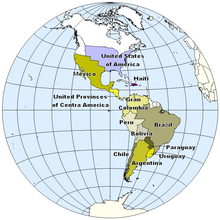
The gradual decline of Spain as an imperial power throughout the 17th century was hastened by the War of the Spanish Succession (1701–14), as a result of which it lost its European imperial possessions. The death knell for the Spanish Empire in the Americas was Napoleon's invasion of the Iberian peninsula in 1808. With the installation of his brother Joseph on the Spanish throne, the main tie between the metropole and its colonies in the Americas, the Spanish monarchy, had been cut, leading the colonists to question their continued subordination to a declining and distant country. With an eye on the events of the American Revolution forty years earlier, revolutionary leaders began bloody wars of independence against Spain, whose armies were ultimately unable to maintain control. By 1831, Spain had been ejected from the mainland of the Americas, leaving a collection of independent republics that stretched from Chile and Argentina in the south to Mexico in the north. Spain's colonial possessions were reduced to Cuba, Puerto Rico, the Philippines, and a number of small islands in the Pacific, all of which she was to lose to the United States in the 1898 Spanish–American War or sell to Germany shortly thereafter.[38]
Portugal and Brazil
Brazil was the only country in Latin America to gain its independence without bloodshed.[
Indian subcontinent and the British Raj (18th century–1947)
The British in India
The
The first major movement against the British Company's high-handed rule resulted in the
During period of the
Other European empires in India

Like the other European colonists, the French began their colonization via commercial activities, starting with the establishment of a factory in Surat in 1668. The French started to settle down in India in 1673, beginning with the purchase of land at Chandernagore from the Mughal Governor of Bengal, followed by the acquisition of Pondicherry from the Sultan of Bijapur the next year. Both became the centers of the maritime commercial activities that the French conducted in India.[48] The French also had trading posts in Mahe, Karikal and Yanaon. Similar to the situation in Tahiti and Martinique, the French colonial administrative area was insular, but, in India, the French authority was isolated on the peripheries of a British-dominated territory.[49]
By the early eighteenth century, the French had become the chief European rivals of the British. During the eighteenth century, it was highly possible for the Indian subcontinent to have succumbed to French control, but the defeat inflicted on them in the Seven Years War (1756–1763) permanently curtailed French ambitions. The Treaty of Paris of 1763 restored the original five to the French while making it clear that France could not expand its control beyond these areas.[50]
The beginning of the Portuguese occupation of India can be traced back to the arrival of Vasco da Gama near Calicut on 20 May 1498. Soon after this, other explorers, traders and missionaries followed. By 1515, the Portuguese were the strongest naval power in the Indian Ocean and the Malabar Coast was dominated by them.[51]
Colonization of Oceania and the Pacific Islands (18th–20th century)
New Imperialism: Africa and East Asia (1870–1914)
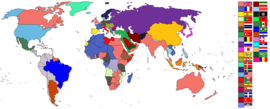
The policy and ideology of European colonial expansion between the 1870s (circa opening of Suez Canal and Second Industrial Revolution) and the outbreak of World War I in 1914 are often characterized as the "New Imperialism." The period is distinguished by an unprecedented pursuit of what has been termed "empire for empire's sake," aggressive competition for overseas territorial acquisitions, and the emergence in colonizing countries of doctrines of racial superiority which denied the fitness of subjugated peoples for self-government.[52][53]
During this period, Europe's powers added nearly 8,880,000 square miles (23,000,000 km2) to their overseas colonial possessions. As it was mostly unoccupied by the Western powers as late as the 1880s, Africa became the primary target of the "new" imperialist expansion (known as the Scramble for Africa), although conquest took place also in other areas – notably south-east Asia and the East Asian seaboard, where Japan joined the European powers' scramble for territory.[54]
The Berlin Conference (1884–1885) mediated the imperial competition among Britain, France, and Germany, defining "effective occupation" as the criterion for international recognition of colonial claims and codifying the imposition of direct rule, accomplished usually through armed force.
In Germany, rising
Asking whether colonies paid, economic historian Grover Clark argues an emphatic "No!" He reports that in every case the support cost, especially the military system necessary to support and defend the colonies outran the total trade they produced. Apart from the British Empire, they have not favored destinations for the immigration of surplus populations.[56]
The Scramble for Africa

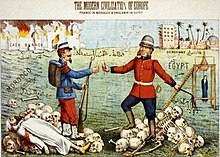
Africa was the target of the third wave of European colonialism, after that of the Americas and Asia.
Leopold II of Belgium personally owned the Congo Free State from 1885 to 1908, under his rule many atrocities were committed.[58] Round after round of international scandal regarding the brutal treatment of native workers forced the Belgium government to take full ownership and responsibility.
The
In the same manner,
The
Imperialism in Asia
In Asia, the
Imperialism also took place in Burma, Indonesia (Netherlands East Indies), Malaya and the Philippines. Burma had been under British rule for nearly a hundred years, however, it was always considered an "imperial backwater". This accounts for the fact that Burma does not have an obvious colonial legacy and is not a part of the Commonwealth. In the beginning, in the mid-1820s, Burma was administered from Penang in Britain's Straits Settlements. However, it was soon brought within British India, of which it remained a part until 1937.[59] Burma was governed as a province of India, not considered very important, and barely any accommodation was made to Burmese political culture or sensitivities. As reforms began to move India towards independence, Burma was simply dragged along.[60]
Interwar period (1918–1939)
The colonial map was redrawn following the defeat of the
Japanese imperialism
For Japan, the second half of the nineteenth century was a period of internal turmoil succeeded by a period of rapid development.
With the final revision of treaties in 1894, Japan may be considered to have joined the family of nations on a basis of equality with the western states. From this same time imperialism became a dominant motive in Japanese policy.
Imperial Japan won conflicts against the Qing dynasty and gained control of Korea and Taiwan when the Treaty of Shimonoseki was concluded in 1895. In 1910, Korea was formally annexed by the Japanese Empire. The Japanese colonization of Korea saw rapid modernization of the peninsula and there was brutal treatment of civilians such as Korean comfort women who were forced to serve in brothels for the Imperial Japanese Armed Forces.[63]
In 1931 Japanese army units based in Manchuria seized control of the region and created the puppet state of Manchukuo. Full-scale war with China followed in 1937, drawing Japan toward an overambitious bid for Asian hegemony (Greater East Asia Co-Prosperity Sphere), which ultimately led to defeat and the loss of all its overseas territories after World War II (see Japanese expansionism and Japanese nationalism). The Imperial Japanese Army committed atrocities exemplified by the Nanjing Massacre.[64]
Second decolonization: Worldwide (1945–1999)
Anticolonialist movements had begun to gain momentum after the close of World War I, which had seen colonial troops fight alongside those of the metropole, and U.S. President Woodrow Wilson's speech on the Fourteen Points. However, it was not until the end of World War II that they were fully mobilised. British Prime Minister Winston Churchill and U.S. President Franklin D. Roosevelt's 1941 Atlantic Charter declared that the signatories would "respect the right of all peoples to choose the form of government under which they will live". Though Churchill subsequently claimed this applied only to those countries under Nazi occupation, rather than the British Empire, the words were not so easily retracted: for example, the legislative assembly of Britain's most important colony, India, passed a resolution stating that the Charter should apply to it too.[65]
In 1945, the
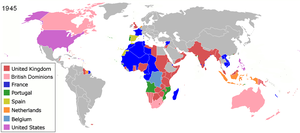
Although the U.S. had first opposed itself to colonial empires, the Cold War concerns about Soviet influence in the Third World caused it to downplay its advocacy of popular sovereignty and decolonization. France thus received financial support in the
Role of the Soviet Union and China
The Soviet Union was a main supporter of decolonization movements and communist parties across the world that denounced imperialism and colonization.[70] While the Non-Aligned Movement, created in 1961 following the Bandung 1955 Conference, was supposedly neutral, the "Third World" being opposed to both the "First" and the "Second" Worlds, geopolitical concerns, as well as the refusal of the U.S. to support decolonization movements against its NATO European allies, led the national liberation movements to look increasingly toward the East. However, China's appearance on the world scene, under the leadership of Mao Zedong, created a rupture between the Soviet and Chinese factions in Communist parties around the world, all of which opposed imperialism.[71] Cuba, with Soviet financing, send combat troops to help left-wing independence movements in Angola and Mozambique.[72]
Globally, the non-aligned movement, led by Jawaharlal Nehru (India), Josip Broz Tito (Yugoslavia) and Gamal Abdel Nasser (Egypt) tried to create a block of nations powerful enough to be dependent on neither the United States nor the Soviet Union, but finally tilted towards the Soviet Union, while smaller independence movements, both by strategic necessity and ideological choice, were supported either by Moscow or by Beijing. Few independence movements were totally independent of foreign aid.[73] In the 1960s and 1970s, Leonid Brezhnev and Mao Zedong gave influential support to those newly African governments which many became one-party socialist states.
Public awareness
According to Dietmar Rothermund, there is a lack of public awareness about the colonial history in Britain and France.[74]
Postcolonialism
Postcolonialism is a term used to recognize the continued and troubling presence and influence of colonialism within the period designated as after-the-colonial. It refers to the ongoing effects that colonial encounters, dispossession and power have in shaping the familiar structures (social, political, spatial, uneven global interdependencies) of the present world. Postcolonialism, in itself, questions the end of colonialism.[75]
See also
- American imperialism
- Analysis of Western European colonialism and colonization
- Historiography of the British Empire
- Neocolonialism
- Soviet empire
- Western imperialism in Asia
References
- ISBN 978-0-87951-397-9A companion to the PBS Series The Genius That Was China)
{{cite book}}: CS1 maint: postscript (link - ^
Gilmartin, Mary (2009). "9: Colonialism/imperialism". In ISBN 9781446243541. Retrieved 9 August 2017.
Commentators have identified three broad waves of European colonial and imperial expansion, connected with specific territories. The first targeted the Americas, North and South, as well as the Caribbean. The second focused on Asia, while the third wave extended European control into Africa.
- ^ Thomas Benjamin, ed., Encyclopedia of Western Colonialism Since 1450 (2006) 1: xiv–xvi.
- ^ Gilmartin, et al. p. 115
- ^ Jonathan Hart, Representing the New World: the English and French uses of the Example of Spain (2001). pp 85–86.
- ^ Gilmartin, M. (2009). Colonialism/Imperialism. In Key concepts in political geography London: SAGE pp. 115–123.
- ^ Gilmartin, et al. p. 115
- ^ Tonio Andrade, "Beyond Guns, Germs, and Steel: European Expansion and Maritime Asia, 1400–1750." Journal of Early Modern History 14.1–2 (2010): 165–186.
- ^ George Shepperson, "The Centennial of the West African Conference of Berlin, 1884–1885." Phylon 46.1 (1985): 37–48.
- ^ Peter J. Cain, and Anthony G. Hopkins, "Gentlemanly capitalism and British expansion overseas II: New imperialism, 1850‐1945." Economic History Review 40.1 (1987): 1–26. online Archived 8 March 2021 at the Wayback Machine
- ^ Gilmartin, et al. pp. 115–16
- ^ "Which Asian Nations Were Never Colonized by Europe ?". ThoughtCo. Archived from the original on 7 June 2021. Retrieved 2 July 2021.
- ^ Charles R. Boxer, The Portuguese Seaborne Empire 1415–1825 (1969).
- ^ Lyle N. McAlister, Spain and Portugal in the New World, 1492–1700 (1984).
- ^ Staff, history.com (2009). "Ferdinand Magellan". history.com. A+E Networks. Archived from the original on 4 March 2021. Retrieved 14 December 2017.
- ^ Melvin E. Page, Colonialism: An International Social, Cultural, and Political Encyclopedia (2003) 1:361-2.
- ^ Page, Colonialism 2: 770–781.
- ^ Daniel R. Brunstetter, and Dana Partner. "Just war against barbarians: revisiting the Valladolid debates between Sepúlveda and Las Casas." Political Studies 59.3 (2011): 733–752.
- ^ John Frederick Schwaller, The history of the Catholic Church in Latin America: From conquest to revolution and beyond (2011) ch 1–3.
- ISBN 9780205556984.
- ^ Violet Barbour, "Privateers and pirates of the West Indies." American Historical Review 16.3 (1911): 529–566.
- ^ John H. Elliott, Empires of the Atlantic World: Britain and Spain in America 1492–1830 (2007).
- ^ Walter Hixson, American settler colonialism: A history (2013).
- ^ Phyllis Raybin Emert, ed., Colonial Triangular Trade: An Economy Based on Human Misery (1995).
- ^ Bob Moore, and Henk van Nierop. Colonial Empires Compared: Britain and the Netherlands, 1750–1850 (2017).
- ^ Anatole G. Mazour, "The Russian-American Company: Private or Government Enterprise?." Pacific Historical Review 13.2 (1944): 168–173.
- ^ Brian Catchpole, A map history of Russia (1983) pp 6–31.
- Great standing on the Ugra river.
- ^ Allen F. Chew, An Atlas of Russian History: Eleven Centuries of Changing Borders (2nd ed. 1967). pp 14–43.
- ^ John Channon, The Penguin historical atlas of Russia (1995) pp 8–12, 44–75.
- ^ G. L. Bondarevskii, and G. N. Kolbaia, "The Caucasus and Russian Culture." Russian Studies in History 41.2 (2002): 10–15.
- ^ James R. Gibson, "Russian expansion in Siberia and America." Geographical Review (1980) 70#2: 127–136. online Archived 15 February 2017 at the Wayback Machine
- ^ George Lensen, ed. Russia's Eastward Expansion (1964) is a short history that uses excerpts from primary sources.
- ^ Martina Winkler, "From ruling people to owning land: Russian concepts of imperial possession in the North Pacific, 18th and early 19th centuries." Jahrbücher für Geschichte Osteuropas (2011) 59#3: 321–353, online in English Archived 28 March 2021 at the Wayback Machine.
- ^ Brendan Simms, Three Victories and a Defeat: The Rise And Fall of the First British Empire (2008)
- ^ Stephen Conway, The War of American Independence 1775–1783 (1995).
- ^ Franklin W. Knight, "The Haitian Revolution." American Historical Review 105.1 (2000): 103–115.
- ^ Timothy Anna, Spain & the Loss of Empire (1983).
- ^ "Vasco da Gama: Round Africa to India, 1497–1498 CE". Internet Modern History Sourcebook. Paul Halsall. June 1998. Archived from the original on 28 August 2011. Retrieved 7 May 2007. From: Oliver J. Thatcher, ed., The Library of Original Sources (Milwaukee: University Research Extension Co., 1907), Vol. V: 9th to 16th Centuries, pp. 26–40.
- ^ "The Great Moghul Jahangir: Letter to James I, King of England, 1617 A.D." Indian History Sourcebook: England, India, and The East Indies, 1617 CE. Internet Indian History Sourcebook, Paul Halsall. June 1998. Archived from the original on 18 August 2014. Retrieved 7 May 2007. From: James Harvey Robinson, ed., Readings in European History, 2 Vols. (Boston: Ginn and Co., 1904–1906), Vol. II: From the opening of the Protestant Revolt to the Present Day, pp. 333–335.
- ^ "KOLKATA (CALCUTTA) : HISTORY". Calcuttaweb.com. Archived from the original on 10 May 2007. Retrieved 7 May 2007.
- ^ Rickard, J. (1 November 2000). "Robert Clive, Baron Clive, 'Clive of India', 1725–1774". Military History Encyclopedia on the Web. historyofwar.org. Retrieved 7 May 2007.
- ^ Prakash, Om. "The Transformation from a Pre-Colonial to a Colonial Order: The Case of India" (PDF). Global Economic History Network. Economic History Department, London School of Economics. pp. 3–40. Archived from the original on 26 August 2011. Retrieved 7 May 2007.
- ^ Kashmir: The origins of the dispute Archived 11 September 2010 at the Wayback Machine, BBC News, 16 January 2002
- ^ Davis, Mike. Late Victorian Holocausts. 1. Verso, 2000. p. 173
- ^ Plague. World Health Organization.
- ^ Reintegrating India with the World Economy Archived 4 March 2012 at the Wayback Machine. Peterson Institute for International Economics.
- from the original on 28 February 2021. Retrieved 4 November 2017.
- ISBN 9780739176573. Archivedfrom the original on 28 June 2023. Retrieved 12 November 2020.
- ISBN 9780739176573. Archivedfrom the original on 28 June 2023. Retrieved 12 November 2020.
- ISSN 1467-923X.
- ^ Harrison M. Wright, ed. The "New Imperialism": Analysis of Late Nineteenth Century Expansion (1976).
- ^ Hugh Seton-Watson, The new imperialism (1971)
- ^ Parker Thomas Moon, Imperialism and world politics (1926), online.
- ^ Volker Rolf Berghahn, "German Colonialism and Imperialism from Bismarck to Hitler" German Studies Review 40#1 (2017) pp. 147–162 Online Archived 7 August 2020 at the Wayback Machine
- ^ Raymond Leslie Buell, "Do Colonies Pay?" The Saturday Review, 1 August 1936 p 6
- ^ Thomas Pakenham, The scramble for Africa: The White Man's conquest of the Dark Continent from 1876 to 1912 (2003)
- ISBN 9780547525730.
- ISBN 9780231504249. Archivedfrom the original on 30 March 2021. Retrieved 12 November 2020.
- from the original on 12 January 2022. Retrieved 4 November 2017.
- ^ William L. Cleveland and Martin Bunton, A History of the Modern Middle East (2016) pp 161–224.
- S2CID 222437929.
- ^ Ki-Jung, Kim (1 January 1998). "The Road to Colonization: Korea Under Imperialism, 1897–1910". Korea Journal. 38 (4): 36–64.
- ^ Sandra Wilson, "Rethinking the 1930s and the '15-Year War' in Japan." Japanese Studies 21.2 (2001): 155–164.
- ISBN 9781846145438. Archivedfrom the original on 28 June 2023. Retrieved 12 November 2020.
- ^ "The United Nations and Decolonization". United Nations. Archived from the original on 27 March 2019. Retrieved 27 October 2017.
- from the original on 4 February 2018. Retrieved 27 October 2017.
- ^ "Milestones: 1953–1960 – Office of the Historian". history.state.gov. Archived from the original on 25 March 2021. Retrieved 27 October 2017.
- ^ "Growth in United Nations Membership, 1945–2005". United Nations. 2000. Archived from the original on 17 January 2016. Retrieved 8 October 2006.
- ^ Yahia H. Zoubir, "The United States, the Soviet Union and Decolonization of the Maghreb, 1945–62." Middle Eastern Studies 31.1 (1995): 58–84.
- ^ Chen Jian, "Bridging Revolution and Decolonization: The 'Bandung Discourse' in China's Early Cold War Experience." Chinese Historical Review 15.2 (2008): 207–241.
- ^ Pamela S. Falk, "Cuba in Africa." Foreign Affairs 65.5 (1987): 1077–1096.
- ^ Gerard McCann, "From diaspora to the third world and the United Nations: India and the politics of decolonizing Africa." Past & Present 218.suppl_8 (2013): 258–280.
- JSTOR 45073035.
- JSTOR 24412174.
Bibliography
- Benjamin, Thomas, ed. Encyclopedia of Western Colonialism Since 1450 (3 vol 2006)
- Boxer, C.R. The Dutch Seaborne Empire: 1600–1800 (1966)
- Boxer, Charles R. The Portuguese Seaborne Empire, 1415–1825 (1969)
- Brendon, Piers. "A Moral Audit of the British Empire", History Today (October 2007), Vol. 57, Issue 10, pp. 44–47, online at EBSCO
- Brendon, Piers. The Decline and Fall of the British Empire, 1781–1997 (2008), wide-ranging survey
- Ferro, Marc, Colonization: A Global History (1997)
- Gibbons, H.A. The New Map of Africa (1900–1916): A History of European Colonial Expansion and Colonial Diplomacy (1916) online free
- Hopkins, Anthony G., and Peter J. Cain. British Imperialism: 1688–2015 (Routledge, 2016).
- Mackenzie, John, ed. The Encyclopedia of Empire (4 vol 2016)
- Maltby, William. The Rise and Fall of the Spanish Empire (2008).
- Merriman, Roger Bigelow. The rise of the Spanish Empire in the Old World and in the New (3 vol 1918) online free
- Ness, Immanuel and Zak Cope, eds. The Palgrave Encyclopedia of Imperialism and Anti-Imperialism (2 vol, 2015), 1456pp
- Osterhammel, Jürgen: Colonialism: A Theoretical Overview, (M. Wiener, 1997).
- Page, Melvin E. et al. eds. Colonialism: An International Social, Cultural, and Political Encyclopedia (3 vol 2003)
- Panikkar, K. M. Asia and Western dominance, 1498–1945 (1953)
- Porter, Andrew N. European Imperialism, 1860–1914 (Macmillan International Higher Education, 2016).
- Priestley, Herbert Ingram. France overseas: a study of modern imperialism (Routledge, 2018).
- Stern, Jacques. The French Colonies (1944) online, comprehensive history
- Thomas, Hugh. Rivers of Gold: The Rise of the Spanish Empire (2010)
- Townsend, Mary Evelyn. European colonial expansion since 1871 (1941).
Primary sources
- Melvin E. Page, ed. Colonialism: An International Social, Cultural, and Political Encyclopedia (2003) vol 3 pp 833–1209 contains major documents.
- Bonnie G. Smith, ed. Imperialism: A History in Documents (2000) for middle and high schools
